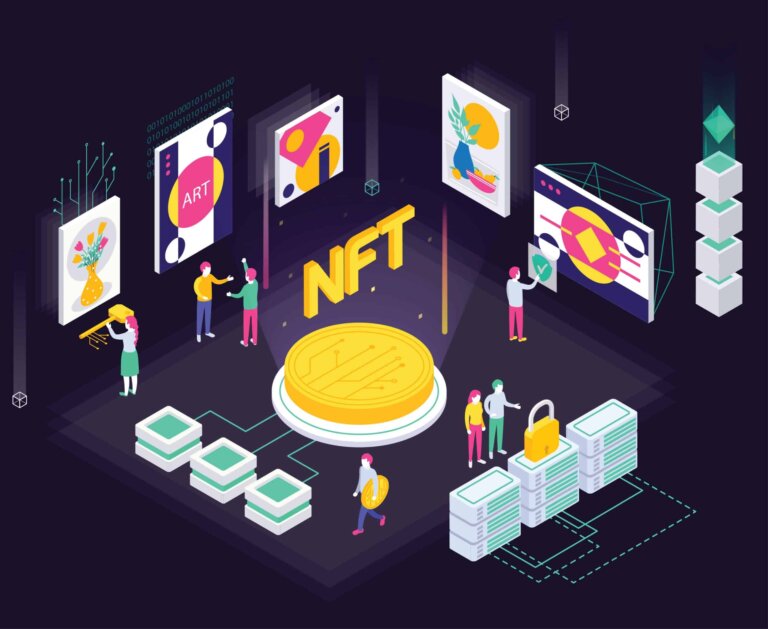Non-fungible tokens are a relatively new creation in a world that seems like it’s increasingly melding art and technology. These assets can go for millions, meaning NFT trademark infringement is a very serious concern.
When the primary value of something lies in its uniqueness, copycat designs can all but eliminate its desirability. This risk increases because many do not understand when NFT trademark infringement occurs. Here is what you need to know about the rights and restrictions of NFTs under intellectual property law.
Defining NFTs and Their Legal Protections
Non-fungible tokens use blockchain technology to create a kind of digital dataset that verifies the sole ownership of an asset. These datasets are sold and traded as investments as they’re used to prove that the asset they represent is unique. Just about any media can be traded, whether it’s an iconic meme-generator like the “Charlie Bit my Finger” video on Youtube or a collection of designs from a famous digital artist.
The protection is supposed to be built into the technology itself. Blockchain can’t be manipulated or changed. It’s an immutable record of ownership. However, because it’s new, legal principles around it are less defined. For the most part, we must rely on copyright law.
Copyright and NFTs
Copyrights apply from the moment a unique artistic work is created. Of course, there’s a problem with this as there are two separate components to consider in an NFT. There is the original artwork itself and the dataset that proves its authenticity. The owner of the original copyright also has the exclusive right to create an NFT of that work.
One problem in the NFT realm has been artists having their original work transferred into an NFT without permission. In some cases, the person who does so will assert a “fair use” exception to copyright law that allows them to reproduce a protected work. Fair use is determined by four factors:
- Purpose of use: Using the work for scholarly reasons is treated far differently than using it for commercial ones. Critiques and education may be considered fair use; commercial is less likely.
- Nature of the work: The type of the copyrighted work itself will also factor into the fair use decision. For example, an iconic, well-known work may be acceptable to use because the fact that it’s iconic is central to the work. Meanwhile, the creation of an unknown artist would be less likely to fall into that category.
- Amount of original work used: A pixel-for-pixel reproduction is likely not fair use, though small reproductions for the purpose of commentary may be acceptable.
- Effects of the use on the work’s value: The examiner will review how the use affected the original work, like if it changed it in some way or made it less valuable.
The creation of an NFT in and of itself is likely not transformative enough to claim someone else’s work. It’s best to think of the NFT as a record of ownership. It is immutable and proves that the person owns the art in question.
But immutable doesn’t mean infallible. It doesn’t prove who owned the art before it entered the digital realm. Consider an NFT built around a brand design or logo. In that case, trademarks may provide a more solid record of ownership.
NFT Trademarks and Infringement
There is a very critical case to watch as the laws around NFT trademark infringement are solidified. It comes from fashion designer Hermès. The company sued digital artist Mason Rothschild for his “MetaBirkins” NFTs, which saw record-breaking sales. Hermès contends that the term “MetaBirkin,” as well as Rothschild’s line of handbag images, violates its trademark and dilutes its brand. Meanwhile, Rothschild argues that his use is a First Amendment exception, comparing it to Andy Warhol’s iconic Campbell’s soup can art. This isn’t the only case of its kind, either. NFTs have been the subject of litigation for Nike as well, as the company is pursuing a similar suit against an exchange selling NFTs of its sneakers.
The decisions on these cases will set the stage for future NFT intellectual property law. For now, we can only do what we know and what we know is prevention. The companies that are the most protected in cases of NFT trademark infringement are the ones that make a point of securing all their IP rights. That means trademarking not just logos, but designs or other materials essential to your brand.
The United States Patent and Trademark Office allows electronic trademark applications, though it’s wise to work with an attorney to ensure you follow the right steps. You’ll be required to prove that your asset is unique to your brand, among other criteria. Of course, this measure only works for branded assets. For artistic works, copyrights exist the moment you create something. However, to pursue a copyright claim, you’ll have to register your work through the US Copyright Office.
NFT trademark infringement is a continually developing area of the law, so it’s best to take practical steps. Work with an attorney to protect your assets as the courts iron out how the IP rights in NFT ownership are handled.
Bold Patents can help you understand NFT trademark infringement and how other IP laws apply to emerging technology. To learn more, contact us or call 800-849-1913.

